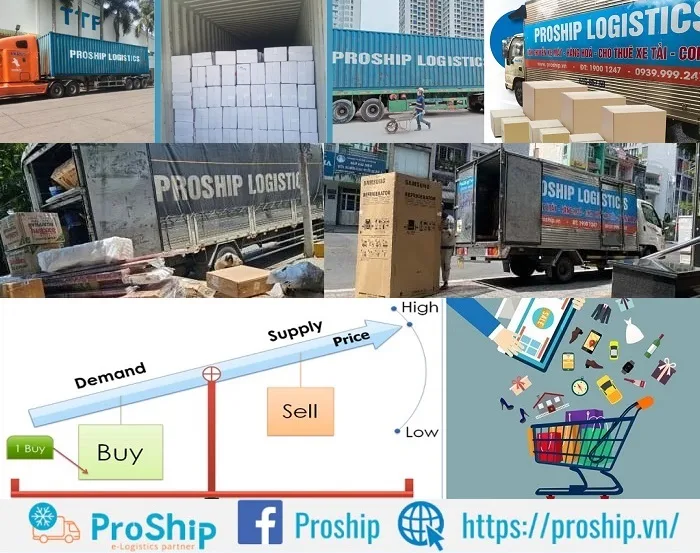x Bạn thắc mắc hàng thứ cấp là hàng gì? Gồm những mặt hàng nào chủ yếu?
x Bạn muốn biết giữa hàng hóa thông thường với hàng hóa thứ cấp có gì khác nhau?
x Bạn quan tâm tới những vấn đề cần lưu ý khi vận chuyển mặt hàng thứ cấp?
Trong quá trình sản xuất và tiêu dùng, hàng thứ cấp là những mặt hàng KHÔNG THIẾT YẾU nhưng vẫn đóng vai trò quan trọng. PROSHIP.VN sẽ giải đáp rõ hơn về khái niệm hàng hóa thứ cấp là gì, ví dụ về hàng thứ cấp, các loại hàng thứ cấp thường vận chuyển cũng như mối liên hệ giữa hàng thông thường với hàng thứ cấp,…Các đơn vị sản xuất nên cập nhật để có kế hoạch quản lý, kinh doanh hợp lý hơn.
📦 Hotline Liên Hệ Vận Chuyển
🧭 Miền Trung
Hàng hóa thứ cấp là gì, ví dụ? Gồm loại nào hàng nào?
Hàng thứ cấp là gì?
Hàng hóa thứ cấp là gì? Hàng hóa thứ cấp (tiếng Anh là Inferior Goods) là thuật ngữ mô tả những mặt hàng có nhu cầu giảm xuống khi thu nhập của người tiêu dùng tăng lên. Điều này xảy ra khi hàng hóa có sản phẩm đắt tiền hơn thay thế, khi thu nhập tăng lên và nền kinh tế được cải thiện, người tiêu dùng sẽ yêu thích sản phẩm thay thế hơn là hàng hóa đó.
Hiểu đơn giản, hàng hóa thứ cấp là loại hàng có cầu giảm khi thu nhập của người tiêu dùng tăng lên hoặc cầu tăng khi thu nhập giảm, trong khi các yếu tố khác không đổi. Thuật ngữ “thứ cấp” thường liên quan đến khả năng thanh toán của hàng hóa thay vì chất lượng của nó, mặc dù một số hàng hóa thứ cấp có thể có chất lượng thấp hơn.

Ví dụ về hàng thứ cấp
Dưới đây là một số ví dụ về hàng hóa thứ cấp:
- Đồ hộp: Đồ hộp như nước ngọt đóng chai, đồ hộp đậu hũ, đồ hộp sữa đặc,…không phải là những mặt hàng cần thiết, nhưng chúng đóng vai trò quan trọng trong việc bảo quản và vận chuyển, đồng thời cung cấp lựa chọn đa dạng cho người tiêu dùng.
- Mì gói: Mì gói không phải là mặt hàng cần thiết cho con người nhưng được sử dụng phổ biến để tiếp cận nhanh với nguồn lương thực. Nó có thể được sử dụng để làm nhanh bữa ăn hoặc như nguồn cung cấp năng lượng dự phòng.
- Bánh mì: Bánh mì không phải là mặt hàng thiết yếu nhưng là một phần quan trọng trong chế độ ăn hàng ngày và từ lâu đã trở thành thói quen ăn uống phổ biến của nhiều người.
Các loại hàng thứ cấp thường vận chuyển
Một số loại hàng hóa thứ cấp được vận chuyển phổ biến, thông dụng nhất như:
- Sản phẩm tiêu dùng: Là sản phẩm giá trị thấp, được tiêu thụ thường như gia vị, bánh mì, mì gói, bột ngọt, nước giải khát, chất tẩy rửa, thuốc lá,…
- Nguyên liệu sản xuất: Là những sản phẩm sử dụng để sản xuất những sản phẩm khác như đường, sắt, bột mì, dầu, nhôm, gas,…
Hàng hóa thứ cấp ảnh hưởng thế nào đến thị trường?
Hàng hóa thứ cấp có ảnh hưởng đáng kể đến thị trường, chính bởi:
- Ảnh hưởng đến giá cả, sự cạnh tranh: Hàng thứ cấp có thể ảnh hưởng đến giá cả và sự cạnh tranh trên thị trường. Việc tăng giảm giá cả và sự cung cầu của hàng hóa thứ cấp có thể ảnh hưởng đến giá bán các sản phẩm chính. Ngoài ra, sự cạnh tranh trong ngành sản xuất và phân phối hàng hóa thứ cấp có thể tác động đến giá bán, chất lượng sản phẩm.
- Đóng góp vào chuỗi cung ứng: Hàng thứ cấp là những phần quan trọng trong chuỗi cung ứng của một sản phẩm. Chúng đóng góp vào việc sản xuất, gia công và phân phối các sản phẩm chính. Nếu không có hàng hóa thứ cấp, quá trình sản xuất và cung ứng sẽ gặp khó khăn và thiếu hụt.
- Tạo việc làm: Các ngành công nghiệp liên quan đến hàng hóa thứ cấp tạo ra nhiều công việc cho người lao động. Việc sản xuất, vận chuyển và xử lý hàng hóa thứ cấp đòi hỏi nhân công và trang thiết bị nên tạo ra việc làm cho nhiều người, đặc biệt là trong các quốc gia có nền kinh tế phát triển.
- Tác động tới môi trường: Quá trình sản xuất và vận chuyển hàng hóa thứ cấp gây ảnh hưởng đến môi trường. Việc khai thác nguyên liệu, tiêu thụ năng lượng và xử lý chất thải gây ô nhiễm và tác động tiêu cực lên môi trường nên việc quản lý và tái chế hàng hóa thứ cấp rất quan trọng.
📦 Hotline Liên Hệ Vận Chuyển
🧭 Miền Trung
Phân biệt hàng hóa thông thường với hàng hóa thứ cấp
Hàng hóa thứ cấp là gì, gồm những loại hàng nào, mức độ ảnh hưởng tới thị trường ra sao đã được chia sẻ. Tiếp theo, việc tìm hiểu mối liên hệ giữa hàng thông thường với hàng thứ cấp cũng cần nắm rõ và hiểu đúng:
| Tiêu chí | Hàng hóa thứ cấp | Hàng hóa thông thường |
| Đối tượng tiêu dùng | Những người tiêu dùng có thu nhập eo hẹp. | Những người tiêu dùng thoải mái về kinh tế và có thu nhập cao. |
| Đặc điểm giá trị | Hàng hóa thứ cấp thường có giá trị thấp hơn và để đáp ứng nhu cầu ngân sách hạn chế của người tiêu dùng. | Hàng hóa thông thường thường có giá trị cao hơn, người tiêu dùng có xu hướng tìm kiếm hàng hóa chất lượng cao hơn và sẵn sàng chi trả mức giá cao hơn cho chúng. |

Theo đó, nhu cầu hàng hóa giảm khi nền kinh tế phát triển, tức là xảy ra mối quan hệ nghịch giữa nhu cầu và thu nhập người tiêu dùng. Sự khác biệt giữa hàng hóa thông thường với hàng hóa thứ cấp là không đồng nhất giữa các quốc gia, khu vực địa lý của chúng khác nhau. Theo thời gian, một số hàng thông thường có thể trở thành thứ cấp (và ngược lại).
>>Xem thêm: Hàng tiêu dùng nội bộ là gì?
Những điều cần lưu ý khi chuyển gửi hàng hóa thứ cấp
Có một số lưu ý quan trọng để đảm bảo an toàn và hiệu quả trong quá trình vận chuyển hàng hóa thứ cấp, đó là:
- Ghi chú về đặc tính và yêu cầu đặc biệt: Cung cấp thông tin chi tiết về đặc tính và yêu cầu đặc biệt của hàng hóa thứ cấp cho Nhà vận chuyển. Điều này sẽ giúp nhân viên vận chuyển hiểu rõ và xử lý hàng một cách thích hợp.
- Đóng gói chắc chắn: Hàng hóa thứ cấp có thể nhạy cảm với va đập, rung động hoặc áp lực. Hãy chắc chắn rằng, khi vận chuyển hàng hóa logistic, hàng hóa được đóng gói chắc chắn và bảo vệ đủ để tránh hư hỏng trong khi vận chuyển.
- Chọn phương tiện vận chuyển phù hợp: Xác định phương tiện vận chuyển phù hợp tính chất hàng hóa thứ cấp. Chẳng hạn, nếu là hàng nhạy cảm với rung động, có thể cần chọn phương tiện vận chuyển có khả năng giảm rung động.
- Xử lý đặc biệt: Nếu hàng thứ cấp đòi hỏi điều kiện nhiệt độ, độ ẩm, ánh sáng hoặc không gian lưu trữ, cần tuân thủ các yêu cầu trong vận chuyển.

- Ghi chú xử lý đặc biệt: Cung cấp hướng dẫn rõ ràng và ghi chú về các yêu cầu xử lý đặc biệt cho hàng thứ cấp. Bao gồm cách xử lý, lưu trữ, và các biện pháp bảo vệ khác.
- Theo dõi và ghi lại: Theo dõi và ghi lại quá trình chuyển hàng đi Bắc Nam. Theo dõi thông tin về vị trí, thời gian và điều kiện vận chuyển để đảm bảo hàng được vận chuyển an toàn, đúng hẹn.
- Bảo hiểm: Nên cân nhắc mua bảo hiểm hàng thứ cấp để phòng ngừa rủi ro, để được bảo vệ và có khả năng bồi thường khi sự cố xảy ra.
- Chọn Đơn vị vận chuyển uy tín: Xem xét và đánh giá phản hồi từ khách hàng trước để xác định độ tin cậy. Bạn cũng có thể so sánh cước vận chuyển hàng giữa các Đơn vị vận tải để có sự chọn lựa tối ưu nhất.
PROSHIP LOGISTICS tự hào là một trong những Đơn vị chuyên cung cấp các giải pháp vận tải hàng đường bộ, đường sắt, đường biển Nhanh an toàn, Chuyên nghiệp, Giá rẻ phải chăng. Điều đó đồng nghĩa với việc dù là hàng thứ cấp hay hàng thông thường cũng đảm bảo “nhận tận nơi – giao tận nơi” cho quý vị. Đặc biệt, chúng tôi đã và đang tích cực đẩy mạnh Dịch vụ vận chuyển hàng bưu kiện, xe máy,…từ Bắc <-> Nam với xe tải 8 tấn, 2 tầng có bửng nâng tiện ích giúp nâng cao khả năng chất chứa hàng của khách.
Thời gian chuyển giao hàng lẻ, hàng ghép, hàng nguyên chuyến luôn chuẩn xác. Ngoài xe tải còn có container đa tải trọng loại 10ft, 20ft, 40ft cùng hệ thống kho bãi tại khu vực Tân Bình, quận 12, Bình Dương với năng lực vận tải lớn sẵn sàng đáp ứng cho mọi nhu cầu gửi hàng từ TPHCM/Hà Nội/Đà Nẵng của Tư nhân, Doanh nghiệp.
Hàng hóa thứ cấp là gì và kiến thức liên quan tới loại hàng này đã được chia sẻ. Các Tư nhân, Doanh nghiệp khi có nhu cầu vận chuyển hàng thứ cấp nên lưu lại thông tin để biết mình cần lưu ý gì và nắm được sự khác nhau cơ bản giữa hàng thường với hàng thứ cấp để đảm bảo đẩy nhanh quá trình sản xuất, vận tải hàng thuận lợi, từ đó giúp gia tăng lợi nhuận trong kinh doanh. Liên hệ ngay với Proship Logistics theo số 0909 344 247 để được tư vấn và báo giá Dịch vụ vận chuyển hàng đi Bắc Nam giá rẻ.
